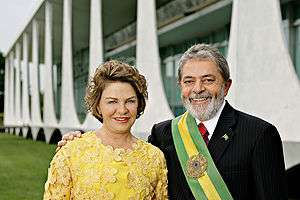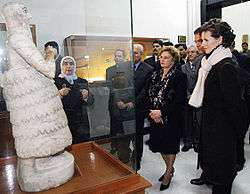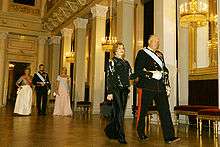Marisa Letícia Lula da Silva
| Her Excellency Marisa Letícia Lula da Silva | |
|---|---|
 | |
| First Lady of Brazil | |
|
In office January 1, 2003 – January 1, 2011 | |
| Preceded by | Ruth Cardoso |
| Succeeded by | Marcela Temer |
| Personal details | |
| Born |
Marisa Letícia Rocco Casa April 7, 1950 São Bernardo do Campo, Brazil |
| Nationality | Brazilian and Italian[1] |
| Political party | PT (1980–present) |
| Spouse(s) |
Marcos Cláudio da Silva (1970–71) Luiz Inácio Lula da Silva (1974–present) |
| Children |
Marcos Cláudio (b. 1970) Fábio Luís (b. 1975) Sandro Luís (b. 1980) Luís Cláudio (b. 1987) |
| Religion | Catholic |
Marisa Letícia Lula da Silva (born Marisa Letícia Rocco Casa on April 7, 1950) is the second wife of former President of Brazil, Luiz Inácio Lula da Silva,[2] and thus she was the First Lady of Brazil, from 2003 to 2010. Lula's first wife, Maria de Lourdes da Silva, died in labour when Lula was in his twenties.
Background
Marisa Letícia Rocco Casa was born in the city of São Bernardo do Campo, in the São Paulo Metropolitan Area. There she grew up, studied, worked, married and built her political militancy. She has been married to Luiz Inácio Lula da Silva since 1974 and has four children and two grandchildren.
Born of Italian grandparents (Lombards from Palazzago, Province of Bergamo), Marisa is the penultimate among Antônio João Casa (son of Giovanni Casa and Carolina Gambirasio) and Regina Rocco's (daughter of Mariano Rocco and Giovanna Boff) eleven children.
Until she was five years old, Marisa lived with her family in the old Casa farm, where her grandfather built the St. Anthony Chapel, still standing to this day. The area is currently known as the Casa neighborhood in honor of her family, one of the first ones to arrive in the area.
In 1955, the family moved to downtown São Bernardo do Campo. Marisa’s first school was made of wood. In third grade she was transferred to the school Grupo Escolar Maria Iracema Munhoz. At age nine she started working as babysitter for three younger girls.
When she was thirteen years old, she got a job at the Dulcora chocolate factory. Because she could not be registered as an official worker, her father signed an authorization so she could work as a chocolate wrapper. She remained in the factory until she was twenty-one, when she became pregnant of her first son.
In 1973, widow and mother of one son of her first marriage, Maria Letícia returned to work, this time as a state school inspector hired by the City Hall. That same year she met Lula at the Metallurgist’s Trade Union of São Bernardo do Campo. Seven months later they got married.
In 1975, Lula was elected Head of the Metallurgist’s Trade Union of São Bernardo do Campo. This period also marked the beginning of Marisa’s political militancy. Always side by Lula, she encouraged other women to participate in the Trade Union of ABCD. Then, in 1978 the strikes began in the ABC region of São Paulo.

The Workers' Party (PT) was founded on 10 February 1980. Marisa cut and sewed the first flag. Being an active militant, she helped to create the various divisions and stamp t-shirts in order to collect funds to the Party. In April of that same year, the Federal Government decreed the intervention in the union. Having lost their gathering space, Marisa’s house became the stage for meetings of unionists, politicians, artists and intellectuals. Then, Lula and other union leaders were arrested.
During this time, Marisa helped to organize a women’s protest march for releasing the Union leaders. Surrounded by policemen, tanks and cavalry, thousands of women and children left Praça da Matriz and walked through Marechal Deodoro street to the Paço Municipal and returned to the Matriz Church. A great act was held with the participation of the then bishop of Santo André, Dom Cláudio Hummes.
During the elections that Lula ran in 1982, 1986, 1994 and 1998 Marisa Letícia shared her time among her children, house and the campaigns. She also participated in the Citizenship Caravans that crossed the country.
In 2002, having raised her four children to adulthood, the wife of candidate Lula was able to dedicate herself entirely to that year’s electoral campaign. At Lula’s side she crossed the country as his most valuable electoral support. Marisa’s constant and marking presence throughout Lula’s trajectory reaffirmed her position as first-comrade.
In one of President Luiz Inácio Lula da Silva’s trips abroad, in October 2003, the First Lady was awarded the Royal Norwegian Order of Merit.
In the 2009, biographical film Lula, o filho do Brasil, Marisa Letícia was portrayed by the actress Juliana Baroni.
On September 19, 2016, as part of the "Lava Jato" (Car Wash) corruption scandal investigation, an indictment for the crime of money laundering against Marisa Leticia Lula da Silva and her husband, former President Lula was accepted by 13th Circuit (Paraná) federal judge Sérgio Moro.
Honours
-
 Dame Grand Cross of the Royal Order of Isabella the Catholic (Kingdom of Spain, 11 July 2003).[3]
Dame Grand Cross of the Royal Order of Isabella the Catholic (Kingdom of Spain, 11 July 2003).[3] -
 Dame Gran Cross of the Royal Norwegian Order of Merit (Kingdom of Norway, 2003).
Dame Gran Cross of the Royal Norwegian Order of Merit (Kingdom of Norway, 2003).
Gallery
 President Lula waves to the crowd with First Lady Marisa Letícia during the 2005 Independence Day military parade in Brasília
President Lula waves to the crowd with First Lady Marisa Letícia during the 2005 Independence Day military parade in Brasília Lula and Marisa Letícia with Pope Benedict XVI in São Paulo, Brazil, 10 May 2007
Lula and Marisa Letícia with Pope Benedict XVI in São Paulo, Brazil, 10 May 2007 Marisa Letícia and King Harald V of Norway attend a state dinner in the Royal Palace in Oslo, Norway, 13 September 2007
Marisa Letícia and King Harald V of Norway attend a state dinner in the Royal Palace in Oslo, Norway, 13 September 2007 The President and First Lady pose for an official photo with the Dutch Royal Family in April 2008
The President and First Lady pose for an official photo with the Dutch Royal Family in April 2008
Notes
References
| Wikimedia Commons has media related to Marisa Letícia Lula da Silva. |
- ↑ (2005-11-30). "Cidadania de mulher de Lula vira polêmica na Itália". .folha.uol.com.br. Retrieved 2014-01-23.
- ↑ East, Roger; Thomas, Richard (2003-08-05). Profiles of people in power: the world's government leaders. Psychology Press. pp. 68–. ISBN 978-1-85743-126-1. Retrieved 24 June 2011.
- ↑ Boletín Oficial del Estado